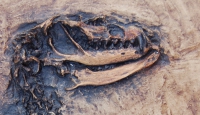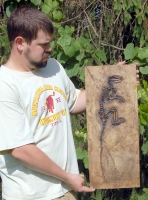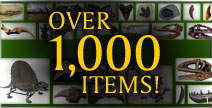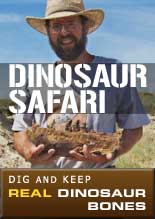
Paroodectes feisti was a primitive Carnivore known from the 49 million year old Messel deposits of Germany. Paroodectes belongs to an extinct family of mammals known as Miacidae. Miacids are among the earliest known Carnivores and probably represent a transitional group. Mammals from the Order Carnivora are known for their sharpened cheek teeth, known as carnassials, which serve for shearing meat. Living Carnivores include dogs, cats, bears, hyaenas, seals, and weasels. All families of Carnivora are thought to be derived from the Miacids.
Paroodectes feisti was the first major mammalian predator discovered at the Messel quarry. The first Paroodectes fossil was discovered by private collector Otto Feist in 1974 and became known to science in 1980. Paroodectes was apparently built for an arboreal lifestyle. The long tail may have served for balance, and the long finges and toes may have been effective for climbing and grasping. Paroodectes probably preyed on ground and tree dwelling Insectivores, Rodents, and Primates that inhabited Middle Eocene forests and swamps.
The Messel quarry, near Frankfurt, Germany is world renowned for the near-perfect preservation of the fossils that it yields. For over 100 years the Messil site had been mined for its oil shale, or "brown coal" as it is commonly called. About 49 million years ago, during the Middle Eocene Epoch, the Messel area was a swampy fresh water lake environment with a rich and diverse flora and fauna. Seasonal blooms of algae in the lakes at Messel would cause the water to be foul and stagnant. If an animal died and fell into the water, its carcass could lay unscavanged and undisturbed in the oxygen-depleted lake bottom. A fine mist of dead algae would cover the organism and preserve it in fine layers of shale. The result is unparalleled preservation of things seldom preserved such as fur, feathers, and gut contents. The Messel quarry offers a nearly complete glimpse of the ancient Messel environment and the animals, birds, reptiles, amphibians, fish, insects, and plants that inhabited Germany 49 million years ago
Polyresin
10x24.75x1.35 inches
Item 1175
Category: Replicas
Type: Skeletons
Phylum: Vertebrates
Class: Mammals
MORE PHOTOS:




Now Over 1,000 Items!
PrehistoricStore.com offers the largest selection of replica fossils and other fossil-related products anywhere in the world!
Download a Full Catalog (3MB PDF)
OVER 260 PAGES OF REPLICAS AND MORE!
